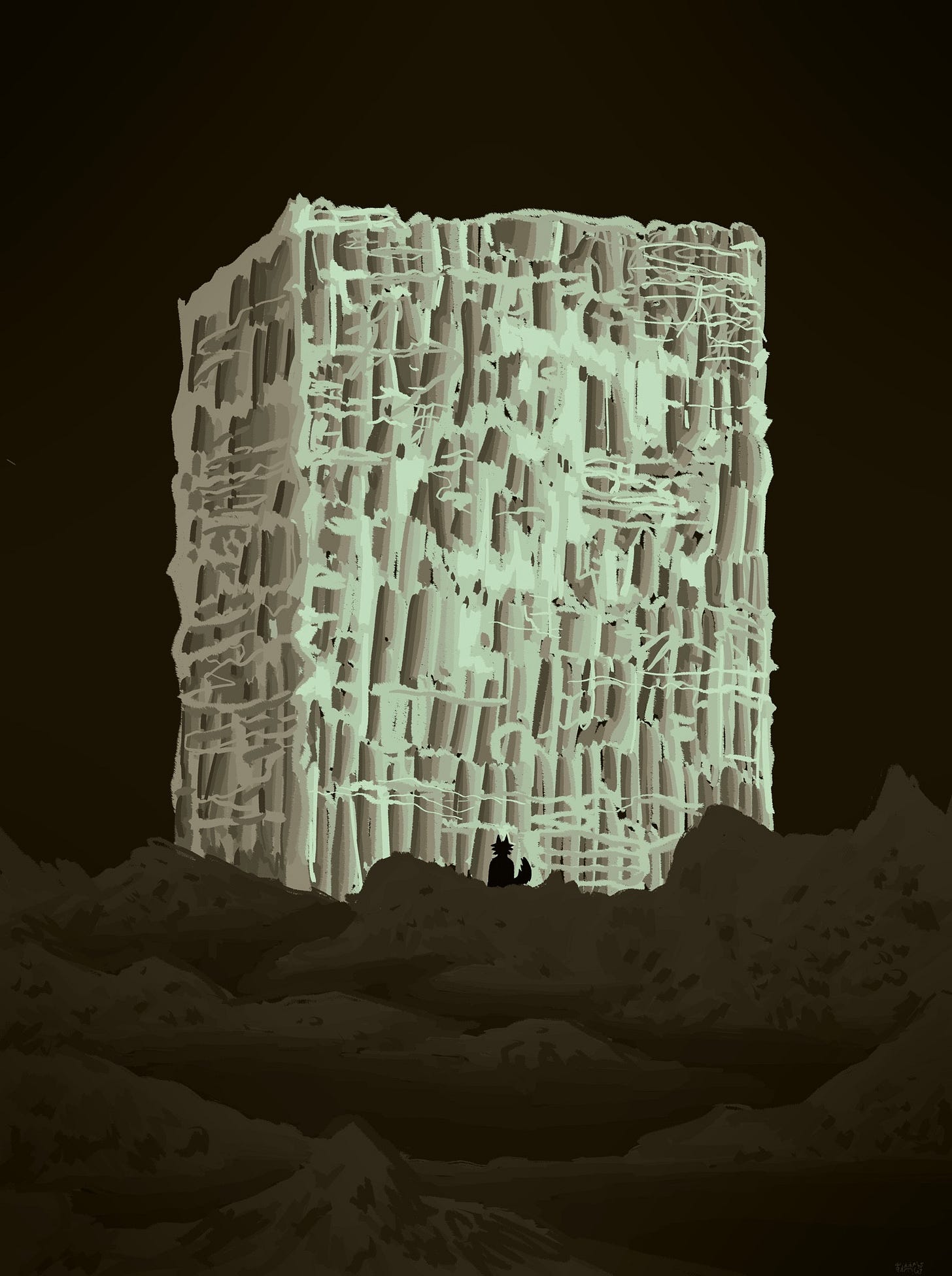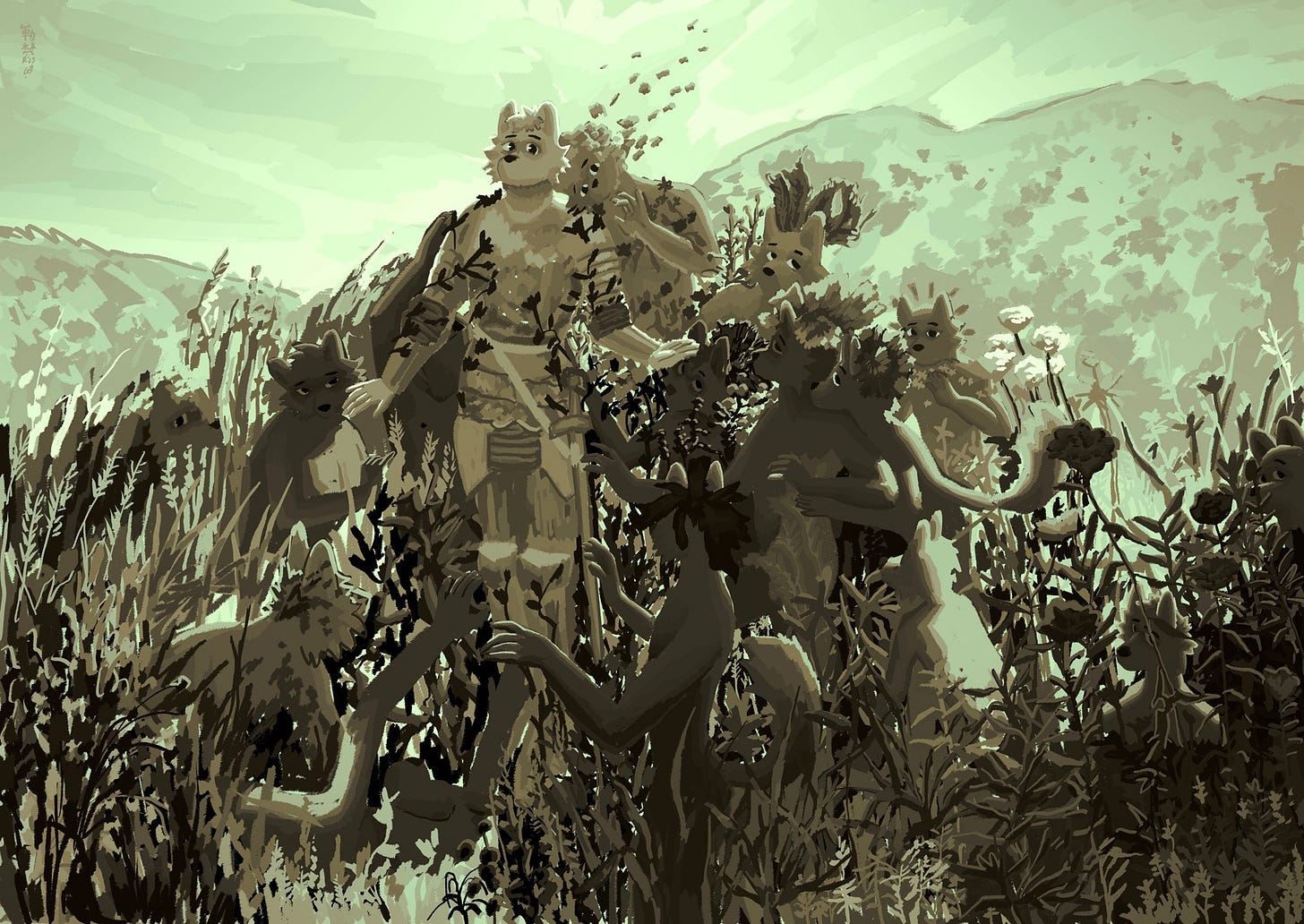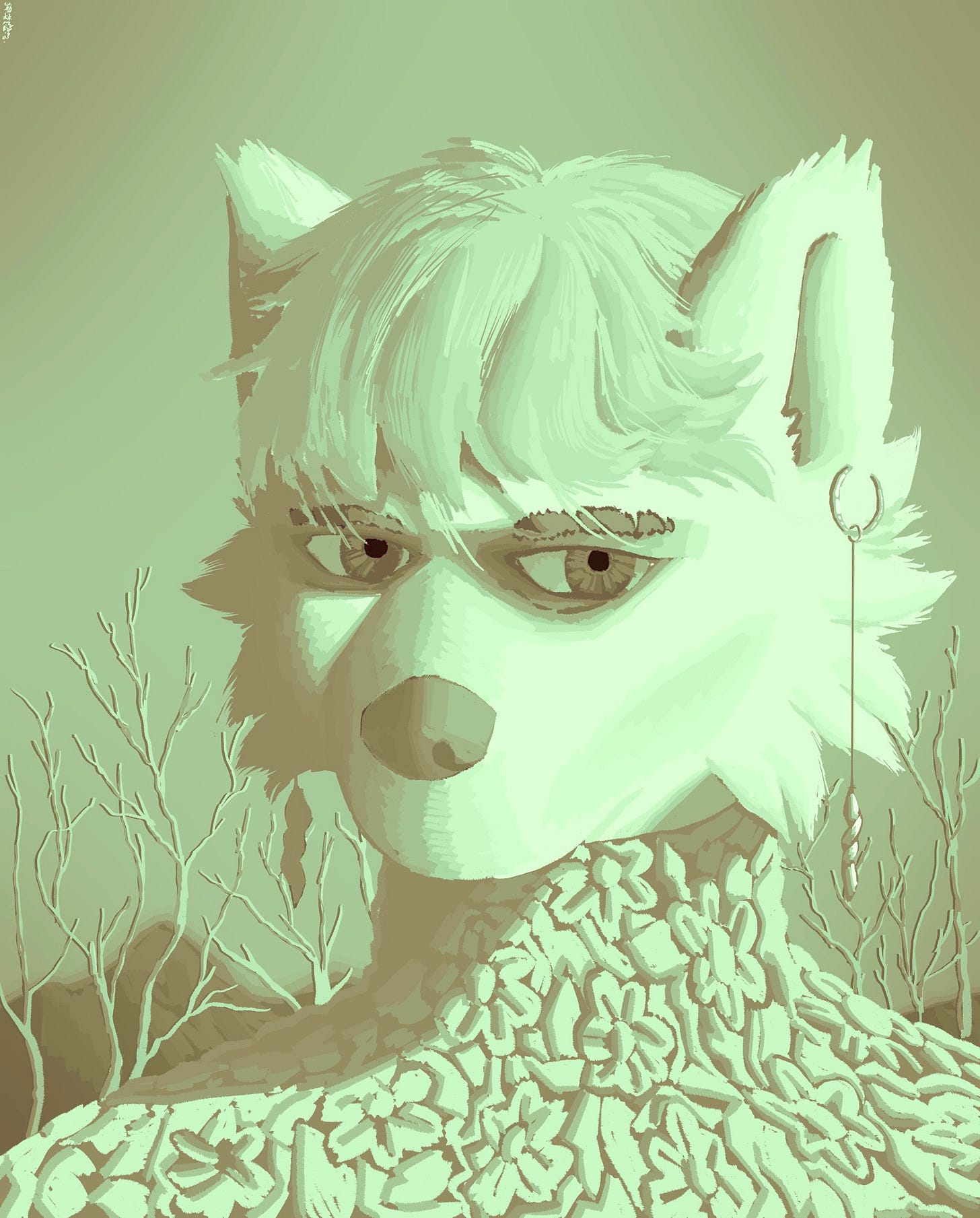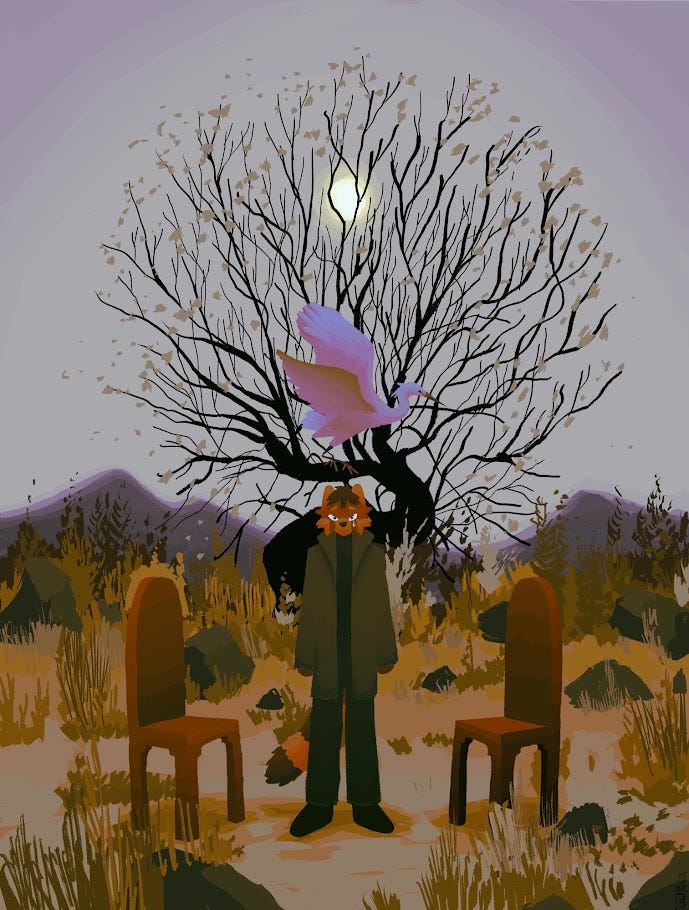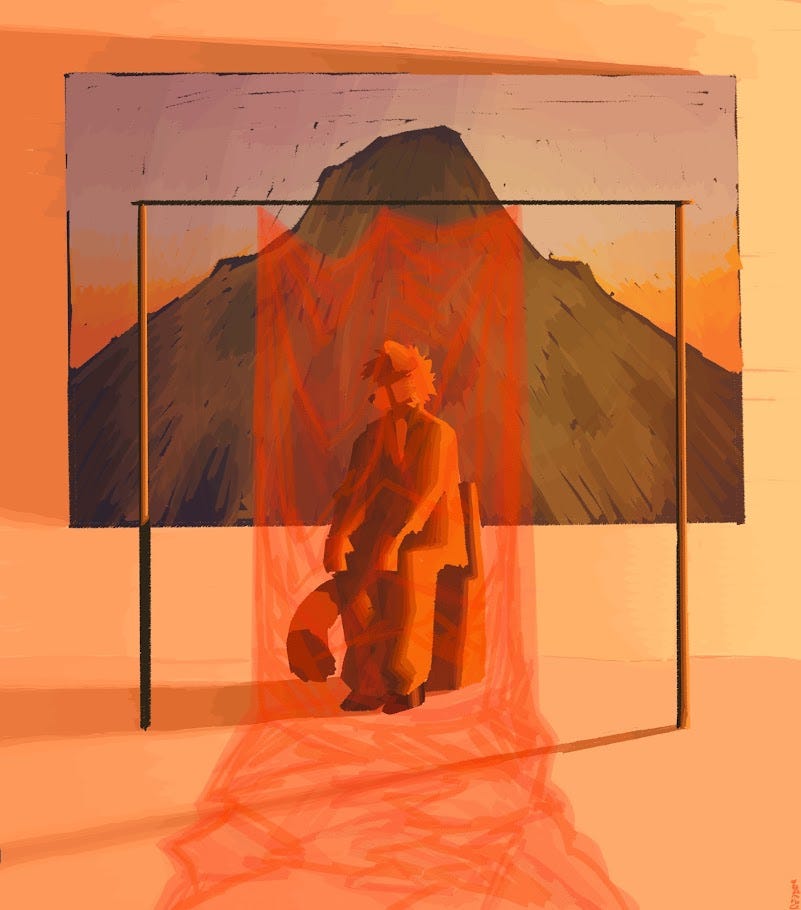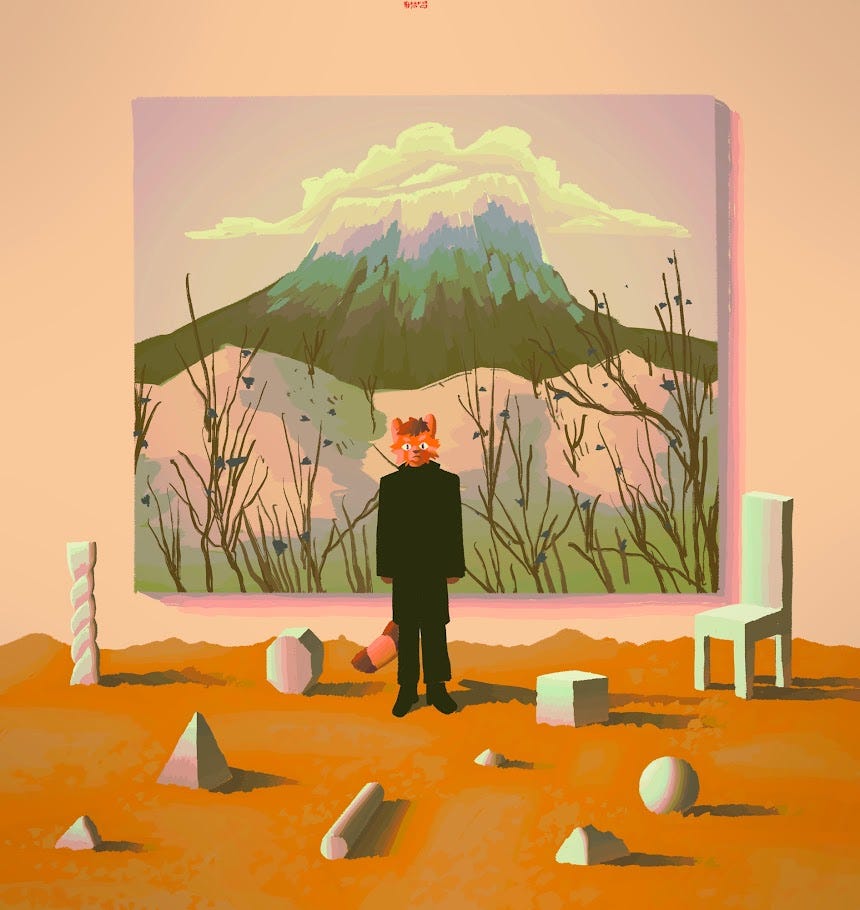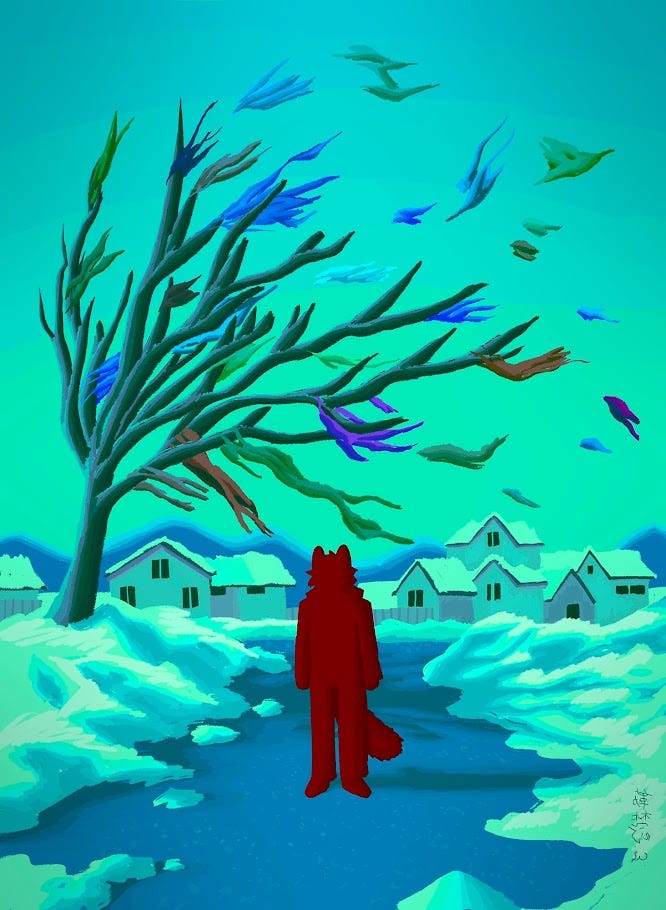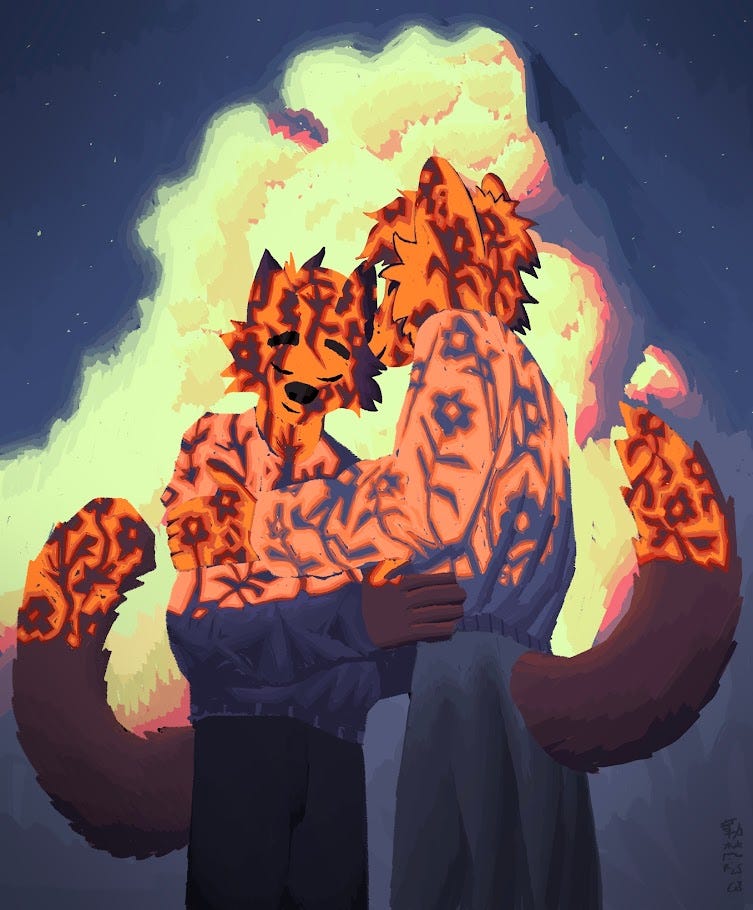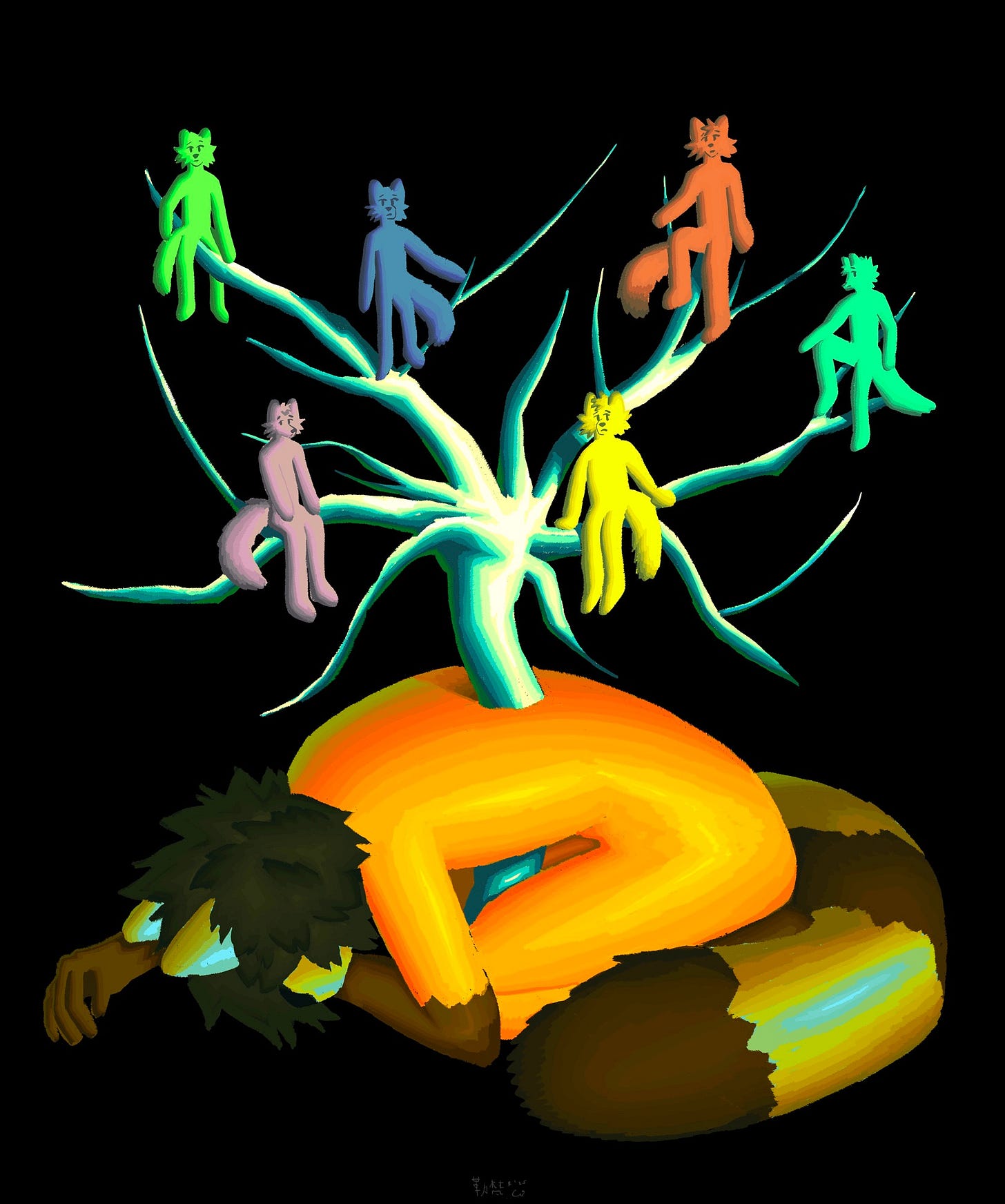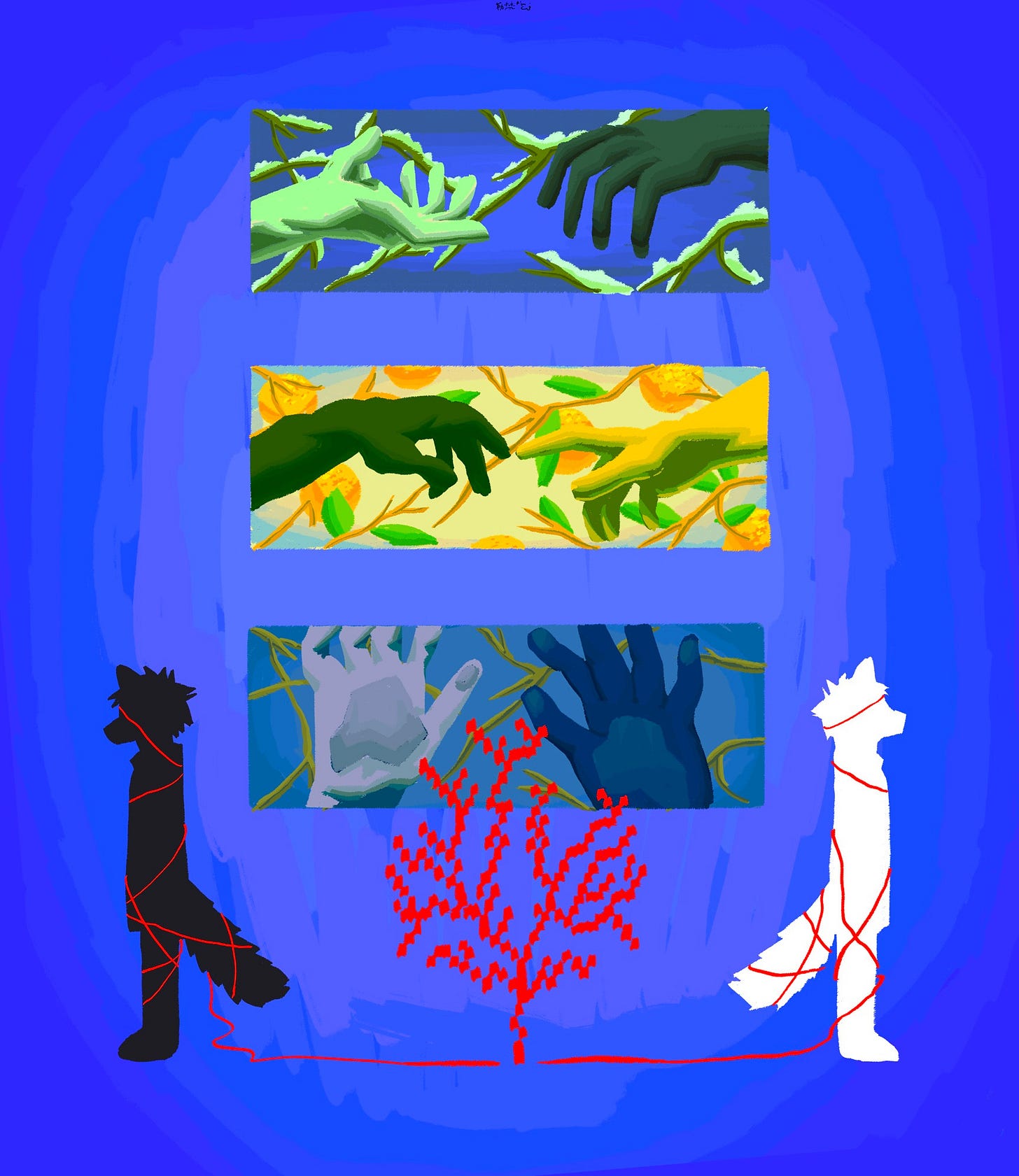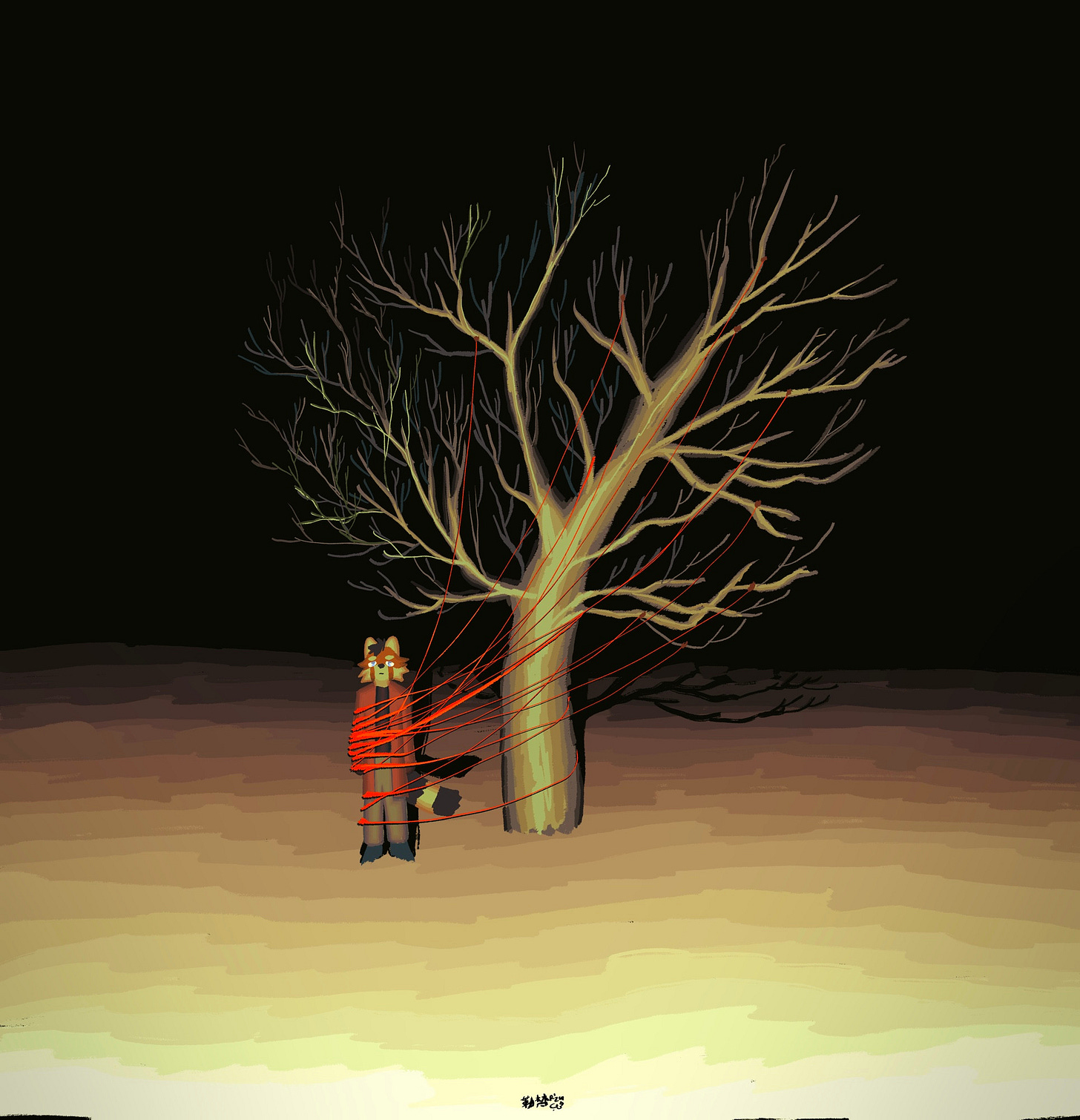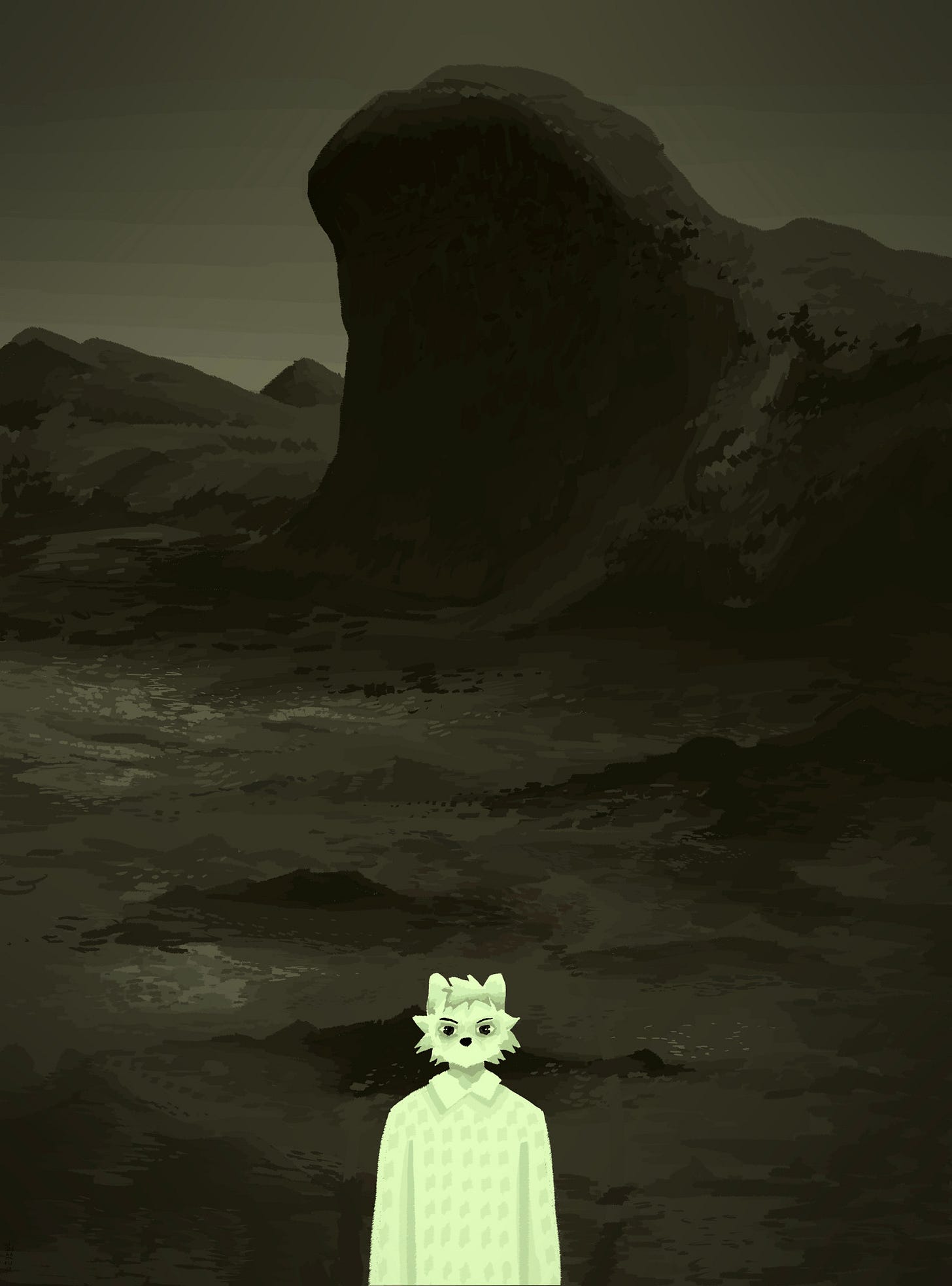Substack has labeled this as “too long for email,” so if you’re viewing the post in an email I recommend going to the app or website instead.
Interviewing people is a new process to me, so what follows may be imperfect in some ways. If you have any feedback on how I could improve my interviews then do let me know. Red (she/her) has been wonderful to talk to and generous with the amount of time she’s given. Because of this, and because I didn’t expect writing out a transcript to take me as long as it has, there will be a part two for this interview posted in the near future! Subscribe for free to be ready for it!
If you’re an artist and you would like to be interviewed, then please reach out! I may not be able to respond to everyone, but I’ll take you into consideration.
This interview was done on 3/16/2025. Red’s Bluesky is: https://bsky.app/profile/wahredpanda89997.bsky.social
Ripple: [Discussing her spicy breakfast] Were you absolutely destroyed?
Red: Yeah, I think so, I had a rough start to begin with in the morning, so it’s like almost 4:00 AM already, and now it’s like a really, really spicy breakfast, unfortunately.
Ripple: Oh no, well I’m sorry it’s a rough start then!
Red: My mouth is still burning as well, but it’s fine.
Ripple: Alright, we will prevail. We stand strong. I had a little bit of a rough-ish morning as well, mostly because I’m a little sleepy today. I probably could have slept more, but there was some noise in the house and I didn’t sleep more. But I’m trying my best as well.
So, first question, very important: Is your favorite color Red?
Red: Red? I mean, um, not really. It’s just because my character is a red panda in terms of species, so my name is red. Color favorite-wise, it’s not really red, it’s mostly just blue, green, and sometimes yellow. Those are my favorite colors and you see them often in my artworks.
Ripple: Something I was thinking of pointing out was that I noticed in the recent past you’ve been doing a lot of more monochromatic drawings, drawings with just one color, you know? And they seem a little more gray/green, which is maybe a contradiction with red as a focus ironically. I also wanted to say there’s a very interesting expression to a lot of the drawings. They sometimes feel like they’re dealing with unsettling feelings, loneliness, loss, or things like that, but I also feel that there’s a lot of ambiguity and still reflectiveness, which is very interesting to me. So what do you think about doing some of these monochromatic drawings, what inspired more of that recently?
Red: I think like… to begin with, I was able to express my emotions, my feelings, whatever that is through color, but then felt like I just, somehow, I went to this realization that I could do something more… maturing the artistic self. I don’t know how to put it, but like once I tried and got into this monochromatic art that I’ve been doing recently, I felt like I could express my emotions, my feelings, my thoughts through a whole new perspective, through a really whole other lens, or you can see another spectrum of it, you know? I mean again, the colored works, yeah, I mean through the colors they can convey a lot of sadness and this and that, whatever you guys name it, and then like I oftentimes use the really vibrant colors to express something that people would usually associate with something that is pale, that is colorless, I use bright colors to express those melancholic feelings, but now that I am going into a really different direction which is like… so like the feelings I am trying to convey are not necessarily stronger, but just something refreshing.
Ripple: Yeah, yeah, it’s a different direction and a new feeling for sure. It feels like when you use a monochromatic color scheme, it could be several things. It could feel more mysterious, or it could feel more quiet… Maybe serious, maybe sad sometimes, but not necessarily, so it’s an interesting choice, I think. So, how did you start doing commissions and posting art online?
Red: I started posting art online back in 2020-ish. I got into the furry art community during COVID and I had the idea to just post my artworks online. Fast-forward to 2021, my ex-partner, he helped me to open my commissions. There’s nothing specific, nothing “exciting,” complex, or whatever. Again, I just started doing furry art during COVID.
Ripple: Yeah, I think the pandemic was a very common time to start looking at furry art. What do you think drew you in that direction?
Red: Another difficult question because I don’t have a particular motivation that turned me to furry art. I just saw my sister drawing on her iPad and I was interested in getting an iPad, so I tried digital drawing and the thing that I wanted to do in the first place was furry art. I find furry art interesting and unique because at first I found it really cute, wholesome. Yeah, nothing much. Furry art is a broad, wide, complex community, I felt very welcomed, I felt like my creativity could expand from that point.
Ripple: Yeah, there’s a lot of space open for people to do new things in that area, I think it’s a good way to express yourself in new and interesting ways. You talk about it being cute, so how do you think that shifted towards the more difficult or dark drawings that you’ve done over time?
Red: I mean, ever since I started furry art, I had already drawn things that are more melancholic. I don’t know what particular reason drew me to such things, but…
Ripple: It came from the heart.
Red: Haha, yeah, you can say that. Maybe that’s the answer I was looking for. It just came from the heart and like… I didn’t know how the furry art felt at that moment, and the most important thing is that I do learn from other furry artists, but very few furry artists. I got very few references, so I dabbled a bit in my own way. I think the secret to my art is I rarely get references from other artists. I developed my own art style, my own direction.
Ripple: Do you think you have a process for coming up with some of the drawings or is it more organic?
Red: Do you mean like where do I get my ideas from?
Ripple: Yeah, is there a way you try to figure out what to do next or is it less planned and more spontaneous?
Red: It could be everything, actually, but most of the artworks I’ve drawn came from life experiences whether it’s happy or sad. It deals with very personal topics. I’ve been going through a lot of personal stuff and those personal things have helped me gain some ideas, so basically most of my artworks are vent artworks. For example, when I was back in college, I felt very scared. I had this phobia of tall buildings and such, and I wanted to translate that feeling into an artwork. So I not only gained that reference through real life experience, but I also went to photography and apps like Pinterest to formulate the idea better. So it’s just from very personal life experiences.
Ripple: That’s a good well of inspiration to draw upon. It interests me that you pointed out the fear of tall buildings because in one of these pictures… It looks like a building, but it reminds me of Zdzisław Beksiński, do you know that artist?
Red: Yeah, I was inspired by his quote-unquote “cathedral drawings.”
Ripple: He does all sorts of those, they're very powerful things, I think because they feel large, but also decayed and strange. So, it grabs my attention. I have looked at Beksiński’s art quite a bit for some of my own inspiration at times, so that was interesting to me. Also, leading from Beksiński, I was going to ask: Have you done any art historical research? I wonder because I noticed a few of your pictures directly referencing old paintings or like a photography studio or gallery. I think they're in Germany, if I got that right. I don't know if I can pronounce the name right, but it's like “Ignant” or something like that?
Red: Yeah, Ignant. So yeah, for some of my works, I’m referencing highly from photography works I found on Ignant. Like I mentioned before, I got references from Pinterest, Ignant… I also, when it comes to referencing historical paintings, I did a bit of research and stuff. And I tried to use the old concepts or ideas and then convert or modify that into my own vision. For example, the Knights of the Flowers painting, it's like in the original painting, the women of the flowers were trying to seduce the knight, but in my artwork, most of them are looking at the viewer as if attempting to seduce, the knight is being disturbed for a moment by the viewer. So, the whole scene is frozen as we stare at a painting that stares back at us.
Ripple: That's interesting! I actually didn't make that observation that you had shifted all the figures’ eyes towards the viewer. It feels like you walked in on something in that way.
Red: Yeah, you just come across that particular scene and they're like, “What the fuck are you doing here?”
Ripple: So it sounds like a lot of the research you did is online, did you do any art history classes or anything like that? I’m curious because I feel like there's a lot of art historical influences in some of what you're doing. To me, there are certain elements that appear very classical like the still life elements with the fruit and similar things like that.
Red: That's quite a difficult question because I barely do things like that, plus I’m very young and I went to college and then I quit college in the very first semester. I didn't even finish my first semester, I quit college early.
Ripple: It happens that way sometimes.
Red: Yeah, so, everything I’ve done was mostly by myself, you know?
Ripple: That makes sense. I just like seeing the art history influences because I did take a bunch of art history classes. It was something I was really curious about, like how you found the things you’re referencing. Another thing I noticed in some of your drawings is that you have words above them occasionally. Maybe it's a title, maybe it's not, but you have things like eudaimonia and so on and so forth, some of those are Greek words, and I think there are a few pictures where you put the word “Almeda” over them? I don't know if I said that right.
Red: Ha, me neither.
Ripple: I was wondering what that meant?
Red: As far as I remember, Almeda is a girl’s name. It also means a mission towards a certain goal. Like you have this… burning motivation and such, you know. Like, again, a mission, I don't know how to put it. There's nothing deep about it in terms of titles and such.
Ripple: I just wondered because it happened more than once, so it's like with this one, for example, I was trying to figure out if there was a story to it. Maybe there's not a lot, but it's a pattern of thought. So, what's the furry community like in Indonesia? Are there conventions there and things like that?
Red: There are conventions, and this July there's going to be another convention in the capitol.
Ripple: Okay, that's very cool. Have you been to some of them before?
Red: No, this is going to be my first time.
Ripple: Oh cool! Well, I hope it goes well.
Red: Thank you, thank you.
Ripple: I also wanted to ask, what are some of your favorite drawings that you've done and why would that be?
Red: Before I move onto that, are there any questions left unanswered? Were you trying to ask about the Almeda piece or something?
Ripple: Oh, I didn’t know exactly where I was going with that, I was just wondering if there was any particular purpose or story to that because I didn’t know what the word meant.
Red: Oh, okay. Before moving onto the next question, you were wondering about this Almeda piece. Just a disclaimer, sometimes I don’t even know what I’m doing, but I was trying to convey the mission to become queer, to be able to express myself. Because I’m a biological male and I became trans and want to express myself as a trans person. This particular piece is not my OC, but it represents my ambition to become queer and to become more feminine. The character wore some big ear piercings and more feminine clothing. It has flower patterns, you know? On the other hand, even though the character is trying to express herself, you can sense this kind of anxiety, this kind of worry, this “I don’t know what I’m doing, are people going to judge me? Are they going to mock me for being queer, for being trans?” I’m just feeling very anxious about it, you know? About expressing myself in such a place where homophobia, transphobia, and such are still a thing, you know? That’s what I was trying to explain.
Ripple: Yeah, it’s a lovely drawing and I can definitely see that with the context in mind. I did look up briefly because I was curious, like what’s the political situation for LGBT rights and so on, and it seems like it’s not very good right now in some ways, which is really unfortunate.
Red: Yeah…
Ripple: But it seems like this art and everything you’re trying to do now is like a part of where you can make a little bit of space to express yourself and be yourself more, which is really good.
Red: So you were asking for a favorite piece of art, right? It’s a very difficult question. For me, there’s no such thing as a favorite artwork or something like that because it’s like… I view my artworks as pieces of puzzles so that they complement and compliment each other. Like the puzzles have the caps, they have the holes, they have the parts that are bulging off the square, they have this form of puzzle pieces that are not uniform. Each artwork is kind of like that and if you connect the puzzle pieces it will become complete. Not necessarily excellently, but it feels like they’re complementing each other. It has, it’s safe for me to say, weaknesses. Still, I admit that my artworks have shortcomings. Things I need to evaluate, to practice, that I need to improve more. At the same time, there are things that are good. For example, in terms of the coloring and the background, it’s all good and stuff. The artworks act as puzzle pieces, they complete each other. Not only in terms of their physical attributes, the things that you see, but also emotionally, also the things you can’t see, but what you can feel. With the sadness, with the happiness, with the melancholy, with the anger, with whatever it is. No favorites!
Ripple: It is hard to pick favorites, for sure. You mentioned puzzle pieces and fitting things together, and I think even in individual pictures you can see things that are in my mind very deliberately sort of neatly arranged, like this drawing here with a crane or a swan, and the sun right above it, and the figure right below it, and the chairs on either side, so it’s very symmetrical with very deliberately placed elements within the picture. It’s very interesting that it’s framed in a particular way, it’s decisive. To share a little more that stood out to me… I thought this one here with the red fabric stood out quite a bit. You’ve got a couple pictures at least where there’s a figure in front of a painting, and it’s a very interesting thing. To me, like especially this second one, it felt a little bit like a surrealist landscape. Like, it doesn’t feel like that painting is in a gallery, it feels like it’s just coming out of the sky or something, and then there are these objects that don’t have any clear organization scattered around. That appeals to me because I do a lot of surrealist type art, so I grab onto that when I see it. And it also feels like maybe the figure is trying to be part of the art by posing in front of it or something? I don’t know. I’m wondering what they’re doing there. Would you have anything to say about it?
Red: Okay, in most of my artworks, some characters, they do belong in their environment, or they do try to fit into the environment, but they can, or they cannot. Or the worst case scenario possible is they can’t fit into the environment. So there are like three possibilities and the second possibility is divided into two. They could succeed fitting, or they don’t… So for these two pieces, they’re not about trying to connect with their surroundings or something. I think it’s more like, “It is what it is?” I don’t know how to phrase it, but for the paintings in the background… It only acts as a background. There’s nothing much, actually. Most of my paintings are not dealing with much big stuff. But what I will say is that emotionally there’s an attachment or detachment to the painting behind them. For example, the red veil, the red cloth, doesn’t really do anything, but there’s an emotional connection.
Ripple: So there’s like maybe themes of emotional connection and disconnection from the environment that they’re placed in? I think I could see that in some of these pictures as well, which are like a figure that’s been made into one color in stark contrast with the environment around it. This is an instance where it maybe doesn’t belong in its environment. At the same time it feels flattened and maybe more unknowable because the features of the face are taken away.
Red: Yeah, this artwork is a really good example of disconnection from the environment. There’s nothing much, it’s just a play of colors and moods and spearing of emotions making things mixed up. I’m trying to leave the audience to guess or experience all of the feelings in everything everywhere all at once.
Ripple: Was that a movie reference, I have to ask?
Red: I’m just taking the words from the title of the movie, though I haven’t really watched it.
Ripple: It’s a good movie!
Red: Indeed, indeed.
Ripple: In stark contrast to some of the more negative emotions in the drawings, this one is very lovely just for the colors on its own. It’s very bright, it’s very glowy, it has a strong sense of light and color in the scene, so I felt that it should be highlighted because the figures themselves are so strongly highlighted with those lovely patterns on them with the shadows. It’s very carefully done in the shadows as well, it’s not just cut out shapes pasted onto the figures, but there’s a gradient with a sort of dark orange outline. There are more colors to give a sense that it’s a softer, less sharp image with those shadows. I just really appreciate the feeling of it.
Red: Thank you.
Ripple: At the same time, the caption on that one was a bit sad and threw into question some of the positivity in the image itself. It says, “In praise of your shadows.” There’s a bit of ambiguity there because I suppose in my mind at least shadows are associated more with dark things, difficult things, bad things, so it’s a mixture of positive and negative, but also in such a way that helps to make the whole picture feel bright. Because the clouds in the background, for instance, wouldn’t feel as bright as they do if it wasn’t for those darker colors in the sky and those shadows. Do you think you deliberately try to put together the positive and negative feelings in pictures like these?
Red: I often do that either intentionally or not. Whenever I go to the comments section they say “Your works are calm, I get a sense of tranquility,” or whatever, this and that, and all of the positive connotations. Also, there’s a sense of loneliness and this and that, the negative connotations. So either I intentionally or unintentionally do that in most of my artworks. So this “In praise of your shadows,” I quote retweeted with the caption, “Could you please say I love you for the last time before you go?” Funnily, it was based on a real experience before I broke up with my long term partner, and I basically asked him, “Could you please give me the chance to say I love you for the last time?” and he was quiet, and I did say, “I love you,” and then the relationship was over. It was a really sad, but a very memorable point in my life.
Ripple: Yeah, it feels very cinematic just looking at the depiction you made of it! It’s a lot of emotion packed into it all at once.
Red: Thank you.
Ripple: How would you like to see the work you’re doing develop in the future?
Red: That’s a very difficult question. I mostly don’t know where I’m going. You’re asking which direction I’d like to go in the future, right?
Ripple: Mhmm.
Red: Ah, okay. I’m not sure yet, there are a lot of options. I could be a freelance furry artist and open commissions. Or I could be a part of the animation industry, or photography. I’m not really focused on that, actually, so I’m afraid I don’t have any answers for that yet.
Ripple: It’s all good. I similarly recently graduated college and I don’t have all the right answers for my future either, I just thought I’d ask to see if you have any big plans.
Red: Big plans? No. But I do have hopes of being able to publish my works in an article, website, or just being able to be talked about and published.
Ripple: To have your work seen by people.
Red: Like, for example, in this case, we’re having this very nice conversation. These are the kinds of things I’m very happy with and looking forward to.
Ripple: I’m glad I could help with some of that even though I don’t have much of a following as it stands.
Red: Thank you so much.
Ripple: I had a thought that I need to get back to this at some point: You mentioned that you’re transitioning or wanting to transition. What pronouns would you want to be referred to with?
Red: Oh, she/her.
Ripple: Good to know, good to know, thank you! Otherwise, anything you’d like to add right now?
Red: I don’t know if you’ve specified this already or not, but is it okay if I ask you some questions in return?
Ripple: Sure!
Red: So, you have said that I was one of the artists in the furry fandom that stood out for you. So, in what way? What interests you somehow? What stood out for you?
Ripple: Yeah, thank you for asking. I think I’ve touched on some of that. I think it’s just that your art feels very, I would say, emotionally driven in that it’s very spontaneous. It feels like it’s coming from a deeply psychological place, or like a storytelling place maybe at times, so it just really interests me to try and figure out what is happening in these pictures, if there is a story, and what the feeling is. So, for another example, we’ve got this drawing here with a tree coming out of this bent over figure with a bunch of little guys on top of the tree branches. And I’m trying to figure out, what is the feeling in this image? Or what is happening? There’s a lot you can dig into and interpret in new and interesting ways. Like what does it mean that all of the little guys in the tree are different colors, or that this person has a tree going through them. It feels a bit violent, but it also doesn’t look gory or anything. It’s more ambiguous, it’s more difficult to understand, and so I find myself very intrigued by things like that, as well as just the amount of emotion that’s put into a lot of the drawings, I really appreciate it.
Red: Right, thank you. Good, because I leave my art to the audience to interpret themselves. Like, I’m doing something, and I let them do the rest. I’m just here being the cook, being the chef, but then I’ll let them experience all the flavors and give appreciation or critique. “The food is a little bit salty, the desert is really sweet,” and this and that, just like that. That’s how I work.
Ripple: Sounds like you’re pretty open to having things be interpreted in different ways and I’m wondering, do you think there’s maybe a distancing between yourself and your art’s meaning maybe? Maybe it’s like… do you think you’re trying to just let it happen as it needs to happen, but not trying to push it to be one way or another? I don’t know if that makes sense.
Red: Wait, wait, wait, you could please repeat the sentence, apologies.
Ripple: You’re fine. I just mean there are some artists who like to think of their work as having a life of its own. I’m thinking of the surrealist artist Max Ernst who wrote at one point that surrealist art is really not made by the artist, the artist is like an observer of its creation, of its happening. So, there’s a suggestion there of being, I suppose, impartial, or trying not to force the art to be anything besides what the idea dictates that it should be. Does that make more sense?
Red: It does make sense, I just unfortunately don’t know the answer yet.
Ripple: That’s fine. I suppose I say that because there’s so much spontaneity in what you’re doing and so much drawing from personal experience and it feels like maybe you’re doing things that feel right sometimes, but don’t necessarily have the right words to describe.
Red: That’s very accurate.
Ripple: And I’d say that’s one of the things that probably makes what you're doing very interesting to me. Because it feels like it has that spirit of trying to make things really curiously and true to the spontaneous feelings that arise and I think that makes very captivating imagery at times.
For another question, you use Procreate, right?
Red: I use Procreate, correct.
Ripple: I have never used it before. I have an old iPad that was abandoned by some roommates I had, but I don’t have a charger for it. So I might get a charger and see if I can make that thing work, but I suppose for my own purposes and questions, what do you think of Procreate as a program? What makes it useful for drawing?
Red: I think it’s just because like… So, in comparison with a drawing tablet, where you have to use monitors and such, you know? I haven’t tried CSP or ibis or something like that, but like in Procreate, you only pay once and then you don’t have to pay a monthly subscription anymore. Like it’s not cheap, but once you have paid, you just get everything that you need. And the reason I draw on an iPad is because I can draw anywhere I want, I can work anywhere I want as well.
Ripple: Right, that can be very convenient. I wish I had a more portable laptop and things like that. My laptop is sort of good for transporting around, but it’s also kind of a large one, so it’s a little inconvenient, and I also just don’t want to damage it. So, sometimes I think to myself, “Wouldn’t it be nice to have something easier to move around with?” So I understand wanting to be able to work in multiple places. Especially for art, you know, maybe you can look at the scenery in different areas and that can help you figure out what to do next.
For more artworks to focus on, there’s a bit of a motif in some of your pictures. There’s a theme of these strings wrapped around figures or things like that. This one here feels very classical, so I wonder if it’s based on anything in particular? But it’s got this little bag of maybe water just hanging down in the middle by a string. And there are other pictures as well with red string, like this one as well. It’s got these red strings wrapped around some people. It seems like it’s saying something about being connected or being trapped. You know, if you think about strings being cut, maybe becoming disconnected. Would you say there’s any particular thought process with that theme?
Red: In general, as far as I know, red string in Asian cultures means something like love or romantic connection and such. For the picture with the tree, the character feels like they’re tied and bound to this lifeless tree for some reason. There’s actually nothing much deeper there. For the one with the plastic bag, I don’t even know what I’m doing. I just loved the idea of the refraction of water with the object behind the water. The plastic bag is see through and you have this refraction and such. It interests me, but I don’t know why I put it in that way, and just put it in such a serious situation. You have this very strange kind of like… you know, something that deserves the whole thing, I don’t know what I was doing. For the blue one and the tree one, yeah, in an Asian culture, as far as I remember, I don’t know which culture, but it represents love, connection, and relationships, and similar.
Ripple: It sounds like on the one hand there’s the very firm, already decided, already known symbolism of the red string as love, but on the other hand, there’s ways that you’re using it where you’re not entirely sure for yourself what it’s doing. So maybe there’s something subconsciously coming out there. Maybe there’s some significance which is not quite reaching the point of conscious expression, but I feel like you can still read into it. I feel like you can still see some sort of meaning in the imagery. Like with the tree, I feel like it plays off of the traditional symbolism a bit. Because whereas love is something nice, beautiful, etc., with the figure tied to the tree it feels a lot more like entrapment, a lot more like not having anywhere to go. And you describe the tree as lifeless, so maybe sometimes there’s a bit of conflict where love can feel lifeless or make you feel like you’re trapped. And I think when it comes to the picture with the bag of water, I definitely see what you’re saying about it just from a visual level being very captivating. I think the way you suggested the light coming through and reflecting off of the red fabric below, I think that’s very lovely and very well done. But I think in terms of the symbolism, in contrast with the figures in the background, it feels like maybe a precarious sort of symbol. What I find myself wondering is if that bag is going to be dropped or the string is going to be cut or something like that because there’s so much tension in the figures behind it. So that’s my interpretation, I don’t know what you think of that.
Red: Don’t worry, I sometimes don’t know what I’m doing either, again. I don’t know what anything means.
Ripple: That’s okay, you don’t have to know what it means in order to have it mean something or be worthwhile and interesting.
Red: My secret to art is authenticity. Like I don’t want to gatekeep things. The key to my art is just authenticity. It’s a really hard thing to come up with, especially because I’m also market focused because I’m trying to gain an audience for the sake of getting commissions. The audience can commission my artwork and this and that, so there’s like a bit of a market going on that comes into play with my artworld, you know? It’s not entirely personal, it’s also not entirely…
Ripple: Not entirely focused on your audience either.
Red: Yeah, yeah. So I do pay attention to the market, and the most difficult part is to try to find the balance between your personal satisfaction and the audience’s taste or interests or satisfaction as well. Like sometimes my art connects with a lot of people, sometimes it doesn’t really connect with a lot of people. Sometimes I pay attention to the engagement or likes and this and that, you know? I used to be very upset if it got very low engagement, but now I don’t really care because art is art and it’s just for the sake of doing art, you know? And sometimes I pay attention to the market and the public taste as well, and I’m trying to find a balance between those two. I’m trying to find the middle ground, the middle part of that Venn diagram or some shit. It’s really difficult, but the secret to my artworks is authenticity, even though it can be hit or miss, sometimes you get recognition, sometimes you don’t. But like, try to be true to yourself. That’s my very based advice for artists, you know? And I hope that artists out there can share, for example, whatever brush they’re using, feedback, and this and that. I don’t like seeing a culture of gatekeeping in the art community, you know? I’ll ask, “What’s your brush?” and they’ll say, “Haha, a brush won’t make you any better.” I really hate that. For art technique, if you’re familiar with smudging, I don’t smudge, I just use hard colors for most of my artworks. If you pay close enough attention to my artworks, I don’t smudge at all, I just use hard colors from the very bright to the very dark, from orange to blue, I just use additional colors instead of smudging it, instead of blurring it out. That’s my technique, again, because I don’t like gatekeeping things. I just want to share.
Ripple: Yeah, I can see that. There’s sort of blocks or areas of one color that show up here and there, and then things move over to different areas with in-between colors. I think that works very well. I feel like that also must create a little bit more deliberateness with some of the color choices. You have a good sense of light and color in a lot of pictures, and I think choosing colors very deliberately in that way with blocks where you’re not smudging them around too much, I think that can have an impact on that since you’ll be slowing down to think about it instead of just trying to mash together whatever’s there.
Red: Those are my conclusions, I think that’s all I have.
Ripple: Thank you for sharing, and I definitely relate to what you were saying about considering both your audience and being true to yourself and your own voice. It sounds like you’re maybe closer to the strategy of seeking that authenticity of making art in the way that you want it, in the way that makes the most sense to you, and then following that, you can let the audience that kind of art needs find you. That’s a really valuable strategy. Because if you start from a place of saying, “Oh, I need to appeal to this kind of person,” then I think it can start to ring really false. It can start to sound really off or heartless even to the people who you’re appealing to. It might lose some essential emotions and care that comes with doing art that’s really personal and important to you.
Red: Right. I think another piece of advice is just to be brave to explore the other side of the fandom, you know? Like in terms of genre or something, if you usually draw something cute or kawaii, like just cuddles and stuff, then maybe you can explore some more sci-fi, more background art, or something emotional. I’m trying to encourage people to go off into very different directions. I’ve seen very few artists that have taken the furry art community to the very next level.
Ripple: I can definitely see that in what you’re doing. I can see the encouragement to experiment a little bit more, to try things that are a little more unusual or a little less of the first thing people think of when they’re trying to do their art. And I really appreciate that about it. Bringing it back to what makes me think what you’re doing is particularly interesting, I think that’s a big part of it. It just feels like it’s trying to elevate the genre a little bit, it’s trying to do things that haven’t quite been done before instead of repeating the same themes in the same way or trying to find an ideal. So, I think that’s a really wonderful part of what you’ve been doing.
Red: Thank you so much. Do you have any curiosity about the environments I draw, like nature, and there’s kind of like this brutalist architecture? Do you happen to question those, or maybe not? It’s up to you.
Ripple: It sounds like it’s an important thing for you, so what would you have to say about that? I do see that the environment and the landscapes are a big part of what you’re doing. How would you say you decide on what landscape elements to use?
Red: I think when it comes to backgrounds, it’s like something that mirrors you in a way that an actual mirror cannot. When you stare at yourself in the mirror, you seem to see yourself, but if you take a look at the environment, then you’re sad and the environment feels sad as well, or when you’re happy, the environment tells you they’re happy as well. You and the environment reflect each other, for some reason, in a way that I can’t really elaborate. That’s why sometimes when I feel very, very doom, very sad, you know, I’ll associate with very worn out buildings and this and that. Or if I feel happy, or if I feel natural, I associate with nature. But at the same time, I do things that contradict my feelings, like I will often do a really colorful background with really cheerful stuff going on and the characters are just sad as fuck or something like that, there’s that irony.
Ripple: I really like that, it’s like there’s a contrast sometimes or an expression even within the landscape. It makes me think a bit about an artist named Kay Sage, who was a surrealist, and she did all sorts of paintings where, sort of unlike a lot of the other surrealists, she would focus on these landscapes, these strange scenes with architecture and unusual buildings, unusual pieces to a landscape. And I suppose I think of her because there’s that expressive element in the landscapes that you choose, and also if I look at some of your drawings, I think there’s a handful where the landscapes do feel a bit unusual, and a bit outside of what you normally see in the world. And very deliberate as well. There’s a deliberateness and a decisiveness to things like this drawing where you have an iceberg right in the middle of an outline of a figure’s head, and then there’s also this drawing here where… I’m trying to figure out if it’s a wave or if it’s a landscape. It feels a bit like a landscape to me, like a big cliff, but it also feels like the cliff is shaped like a wave. There are mountains in the background as well, so it’s something where I’m curious what I’m looking at because it’s a bit hard to make out exactly.
Red: It’s supposed to be a cliff, that’s important. So, in terms of the creative process, one of the most important creative processes is to listen to a song. It’s really related to my feelings and the content of my artworks. The music, I will underline this, doesn’t have to be pleasant to listen to. It doesn’t have to be happy, it doesn’t have to be sad, it doesn’t have to be any certain way, except in a way that you like. Sometimes my personal creative process is that I have to listen to an unpleasant song, or a really happy song, a really strange song, in order to build the environment I’m trying to draw. For example, when I’m trying to draw something that’s really depressing, I’ll listen to Molchat Doma, for example.
Ripple: I’ve listened to them a little bit.
Red: If I want to draw something very nice, I’ll listen to Daniel Caesar, or if I want to draw something surrealist, I’ll listen to Tyler the Creator or something like that. It really depends on what I’m trying to convey, even if it’s not something I particularly want to listen to. It’s a really powerful process for me, personally. Everyone has a different creative process, and I respect that, it’s just how do I work? That’s the thing I haven’t mentioned before.
Ripple: That makes a lot of sense, I think especially because music is a viscerally emotional artistic medium, and also the kinds of drawings you do stem very directly from emotions and personal experience, so I think that makes a lot of sense. I used to do a lot more music listening while drawing or painting, I think I’ve become less deliberate about it or less focused on it over time. Perhaps this could be an inspiration for me to try choosing my soundtrack more decisively when working. Anything else you’d like to talk about now?
Red: I think that’s all for now. I would like to say thank you for this opportunity, I’ve never been interviewed before. I’m really happy and I can’t wait for you to publish it somewhere. My family and friends are excited to see the interview.
Ripple: Awesome, I’m glad to hear it! Thank you for taking the time to talk to me, I appreciate it as well.


